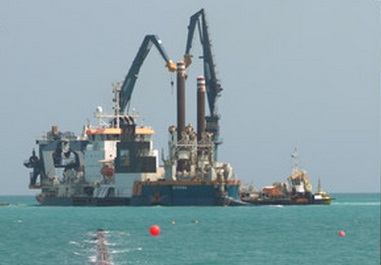 |
 |
||
Significant expansion for Van Oord |
||||||||||||
The year 2014 was exceptional in many ways. From a financial perspective, Van Oord achieved a record turnover of EUR 2.104 billion (2013: EUR 1.641 billion). It is the first time in the companyРІР‚™s history that its turnover has exceeded EUR 2 billion.

Turnover and resultsThe year 2014 was exceptional in many ways. From a financial perspective, Van Oord achieved a record turnover of EUR 2.104 billion (2013:Р ’ EURР ’ 1.641Р ’ billion). It is the first time in the company’s history that its turnover has exceeded EUR 2 billion. This year, with the award of the Gemini project (EUR 1.3 billion in turnover), Van Oord became one of the major players in the European offshore wind industry. Van Oord’s turnover was not the only thing that broke records: its order portfolio was well-filled, and was valued at EUR 3.222 billion at year-end 2014 (2013:Р ’ EURР ’ 1.944 billion). The net profit for 2014 amounted to EUR 119 million (2013: EUR 130 million; the profit for 2013 was considerably influenced by settlements reached on outstanding claims that arose in the Dubai era).Р ’ StrategyVan Oord’s strategy continues to focus on its three current activities: dredging, offshore oil & gas, and offshore wind. Pieter van Oord, CEO: ‘This strategy is aimed at both strengthening and investing in our position in our existing main activities. In addition to the investments in new vessels, the acquisitions of J.T. Mackley & Co. (United Kingdom), the staff and equipment from Ballast Nedam Offshore, and all of the shares in Dravo S.A. (Spain) in 2014 fit right into this strategy.’ ActivitiesDredging People, safety, and sustainabilityVan Oord’s staff grew in 2014 from 4,195 to 4,843 employees. Pieter van Oord: ‘Van Oord will continue to raise its profile on the labour market and recruit new people. During the National Career Fair in 2014, Van Oord was named “favourite employer in the marine contracting sector” and we received an award for our trainee programme.’ There were also fewer accidents in 2014. Although Van Oord’s long tradition of reducing the number of accidents resulting in absence continued last year, the company is still devoting undiminished attention to a safe work environment, because even one accident is one too many. In 2014, as part of the Safety Leadership Programme, more than 300 managers received extra training, and safety awareness has increased enormously in comparison to three years ago. Leadership plays a prominent role in safety. When it executes its projects, Van Oord also has to deal with their effects on the environment. Because sustainability is important to Van Oord, it has become an essential part of both the company’s strategy and its activities. In 2014, for example, various Guards developed by Van Oord (ReefGuard, FaunaGuard, and PlumeGuard) and eco-engineering solutions were included in tender proposals and were actively applied during projects such as Eneco Luchterduinen (the Netherlands), Liverpool 2 (United Kingdom), Sandy Bottom (Bahamas), and KNPC (Kuwait). In 2014, the company focused on the energy efficiency of the fleet: two-thirds of Van Oord’s self-propelled vessels have been awarded International Energy Efficiency Certificates and the order for two new trailing suction hopper dredgers specifies fuel efficiency as a top priority. The company’s CO2 footprint in 2014 was reduced by 10% compared to 2010. Investment programmeAccording to Van Oord’s 2013-2018 Strategic Plan, the company will be investing more than EURР ’ 1Р ’ billion in building new vessels and modernising and replacing the fleet. In 2014, this investment included an order for a new fallpipe vessel, Bravenes, which is currently being built by the Sinopacific Shipbuilding Group Shanghai at its shipyard in Ningbo, China. Two trailing suction hopper dredgers are also being developed and have been ordered; these vessels are now under construction at the LaNaval shipyard in Spain. The offshore wind division was also strengthened by the acquisition of the staff and equipment from Ballast Nedam Offshore. Investments made earlier also paid off in 2014, with events such as the successful introduction of the Aeolus, a vessel designed for offshore and wind projects, and the construction of the Nexus, the cable-laying vessel that was launched on 7 March 2015. The Aeolus was delivered in July 2014 and was first deployed to the Eneco Luchterduinen offshore wind park project. The introduction of the Aeolus to the fleet was incredibly successful. After Eneco Luchterduinen is completed, the Aeolus will be deployed to the Gemini project. The Nexus will also be deployed to this project after being launched in spring 2015. Financing and shareholdingsThe company is financially sound. There were no changes either in its financing or its shareholding ratios in 2014. Van Oord N.V. is a public limited company with its head office in the Netherlands. MerweOord BV, the holding company owned by the Van Oord family, holds 78.5% of its shares. The remaining shares are held by Cobepa (Nederland) N.V. (10.75%) and ConsOord B.V. (10.75%). OutlookPieter van Oord: ‘On balance, the sharp drop in the price of oil has not been good for our company. A much lower oil price means that large oil and gas companies will postpone starting projects and making investments. We’ll be feeling most of the effects of this during and after 2015. Conversely, the drop in the value of the euro against other major currencies, including the dollar, will help us in 2015 by reducing our operating costs in countries that use the dollar. We remain optimistic about our opportunities for growth in offshore wind projects. The fact that our order portfolio for 2015 is so well-filled gives us confidence about this year. Our turnover and activities will continue to expand.’
|
||||||||||||
|
||||||||||||
| « Back to all news | ||||||||||||

|
|
 |
|
|
||||||||||||